As technology evolves, so does the way we acquire knowledge. The Learning Management System (LMS) is a prime example of this evolution, acting as a bridge connecting learners and educators in the digital realm. One such LMS variant that has been gaining traction is the Open Source LMS. Its flexibility, customisability, and cost-effectiveness make it a tempting choice for many. But how does one navigate the open source waters? This article aims to guide you through “The Right Way To Go About Open Source LMS.”
Understanding Open Source LMS
What is an Open Source LMS?
Open Source LMS refers to a learning management system whose source code is openly available to users. This means you can customise and modify the software according to your specific requirements, giving you a level of control that is unparalleled in proprietary LMS.
Open Source vs Proprietary LMS
While proprietary LMS is often ready-to-use, with robust support and fewer bugs, they lack the flexibility that Open Source LMS offers. With open source, you’re the captain of your ship; you control the software’s evolution, ensuring it aligns with your needs.
The Right Way To Go About Open Source LMS
Identifying Your Requirements
Knowing your needs is the first step in the journey. How many users will you have? What kind of courses will you offer? What features do you need? These answers will guide your choice of Open Source LMS.
Choosing the Right Open Source LMS
Once you’ve pinned down your needs, it’s time to select the Open Source LMS that aligns with these requirements. Research extensively, read reviews, and compare options before making a decision.
Customisation and Integration
Here’s where Open Source LMS truly shines. Modify the source code to align the software with your needs. Integrate it with other platforms used by your organisation for seamless operation.
Testing
Before rolling out your Open Source LMS, test it extensively to ensure it works smoothly. Identify bugs and fix them to guarantee a glitch-free learning experience for your users.
Training and Support
Training users and providing continuous support ensures a smooth transition and aids in overcoming resistance to the new system.
Pros and Cons of Open Source LMS
The Upside
Open Source LMS offers flexibility, customisability, and cost-effectiveness. It allows you to tailor the software to your specific needs, unlike a one-size-fits-all proprietary LMS.
The Downside
On the flip side, Open Source LMS often requires technical expertise for customisation and maintenance. Moreover, support may not be as robust as that of a proprietary LMS.
Successful Open Source LMS Examples
Moodle, Chamilo, and Sakai are some of the most successful open-source LMS options. They offer extensive customisation options and have been adopted by numerous organisations worldwide.
Frequently Asked Questions
What is Open Source LMS?
Open Source LMS is a Learning Management System where the source code is publicly available. This allows for significant customisation and modification to fit specific requirements.
Why Choose Open Source LMS?
Open Source LMS offers unparalleled flexibility and customisation, allowing you to shape the software according to your needs. It’s also often more cost-effective than proprietary LMS.
What are the Disadvantages of Open Source LMS?
While open source LMS offers many benefits, it also requires technical expertise for modification and maintenance. Additionally, the support might not be as comprehensive as that offered by proprietary LMS.
How Do I Implement an Open Source LMS?
Implementing an Open Source LMS involves identifying your needs, choosing the right LMS, customising it, testing it, and providing training and support to users.
Can I Modify an Open Source LMS?
Yes, one of the primary advantages of an Open Source LMS is the ability to modify its source code, allowing you to customise the software to fit your specific requirements.
Are there Successful Examples of Open Source LMS?
Yes, Moodle, Chamilo, and Sakai are examples of successful open-source LMS platforms used by organisations globally.
Conclusion
Open Source LMS offers an exciting opportunity to take control of your learning environment. It may seem like a daunting journey, but with clear understanding, meticulous planning, and the right support, it’s a journey worth embarking on. Remember, in the realm of open source, the only limit is your imagination!
As an online course entrepreneur, having a learning management system to help you showcase your brand is very important. The Green LMS platform for entrepreneurs allows you to create, market, and sell online courses from one place. It features a customizable visitor portal, online course landing pages, a public blog, and more, so you can personalize your website and tell a compelling brand story. Read more about LMS for Business, LMS for University and College,
Sign up for a free 14-day trial and see for yourself.


